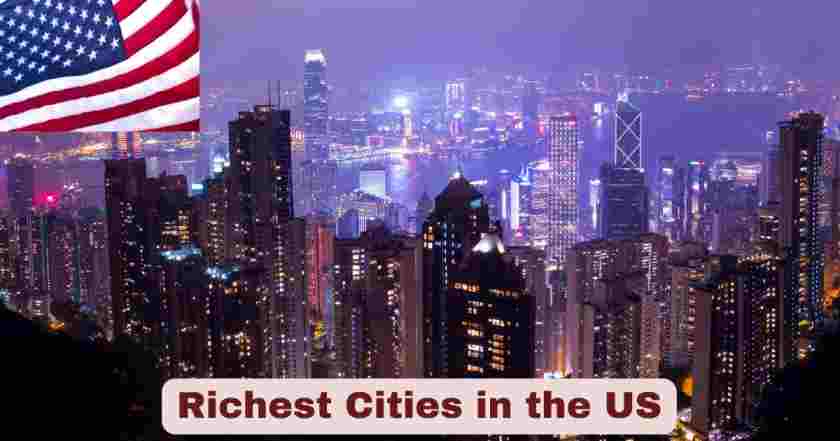Richest Cities in the US 2025
The economic landscape of America’s wealthiest metropolitan areas continues to demonstrate remarkable resilience and growth in 2025, with the richest cities in the US 2025 leading the nation’s financial recovery and expansion based on nominal GDP output. These metropolitan powerhouses serve as economic engines driving innovation, attracting top talent, and generating substantial wealth across diverse industries from technology and finance to entertainment and healthcare. According to the latest data from the U.S. Bureau of Economic Analysis, these wealthy urban centers have shown exceptional performance, with the top 10 cities alone contributing over $7.3 trillion to the national economy.
Understanding the wealth distribution among America’s cities requires examining comprehensive economic indicators that focus on total economic output and GDP contribution to measure true economic impact. The richest cities in the US 2025 represent not just centers of individual wealth accumulation but complex economic ecosystems that foster entrepreneurship, innovation, and sustainable growth. These metropolitan areas have successfully navigated economic challenges while maintaining their positions as global financial and technological hubs, attracting billions in investment and creating millions of high-paying jobs across multiple sectors.
Core Criteria for Ranking Richest U.S. Cities
- Gross Domestic Product (40% weight) – Total economic output of metropolitan area from Bureau of Economic Analysis
- Median Household Income (25% weight) – Annual household earnings adjusted for inflation, sourced from U.S. Census Bureau American Community Survey
- Total Private Wealth (20% weight) – Net worth of all residents including real estate, investments, and business ownership from Bureau of Economic Analysis
- Cost of Living Adjustment (8% weight) – Real purchasing power calculation from Bureau of Labor Statistics Consumer Price Index • Millionaire Density (4% weight) – Number of millionaires per 100,000 residents from Wealth-X Global Wealth Reports
- Employment Rate (2% weight) – Percentage of working-age population employed from Bureau of Labor Statistics
- Real Estate Values (1% weight) – Median residential property values from Federal Housing Finance Agency
To identify the richest cities in the US 2025, analysts primarily focus on nominal GDP output, which reflects the total economic value generated within metropolitan areas and carries the highest weight at 40% in comprehensive ranking methodologies. Cities with high GDP output demonstrate robust economic activity across multiple sectors, making this metric the most reliable indicator of overall economic strength and wealth generation capacity within a metropolitan area. This approach, sourced from the U.S. Bureau of Economic Analysis, captures the full scope of economic activity including corporate profits, employment income, and business investment rather than focusing solely on individual household prosperity.
Another key metric is median household income, weighted at 25%, which reflects the financial health of the average resident and ensures that GDP growth translates into broad-based prosperity rather than concentrated wealth accumulation. Cities with strong GDP performance combined with high median incomes demonstrate sustainable wealth creation that benefits entire communities rather than just corporate entities or wealthy individuals. Total private wealth at 20% weighting includes the net worth of all residents covering assets like real estate, investments, and business ownership, providing insight into long-term wealth accumulation within metropolitan areas among the richest cities in the US 2025.
Key Facts About Richest Cities in the US 2025
| Economic Indicator | Statistical Data | Source | Timeframe |
|---|---|---|---|
| Top 10 Cities Combined GDP | $7.3 trillion total output | U.S. Bureau of Economic Analysis | 2025 |
| New York City GDP | $1.87 trillion annual output | Bureau of Economic Analysis | 2025 |
| Los Angeles GDP | $1.13 trillion annual output | Bureau of Economic Analysis | 2025 |
| Metropolitan Income Growth | 6.0% annual increase | U.S. Bureau of Economic Analysis | 2024 |
| Metro vs Non-Metro Growth | 6.0% metro vs 4.7% non-metro | Bureau of Economic Analysis | 2024 |
| National Real GDP Q2 2025 | 3.0% annual growth rate | Bureau of Economic Analysis | Q2 2025 |
| Financial Sector Employment | 1.8 million jobs in top 10 cities | Bureau of Labor Statistics | 2025 |
| Technology Sector Employment | 2.2 million jobs in top 10 cities | Bureau of Labor Statistics | 2025 |
The comprehensive data reveals the exceptional economic performance of the richest cities in the US 2025, with the top 10 metropolitan areas alone generating $7.3 trillion in combined GDP, representing approximately 30% of the entire U.S. economy. New York City’s extraordinary $1.87 trillion GDP output exceeds the entire economic output of most countries, while Los Angeles’ $1.13 trillion contribution demonstrates the scale and impact of America’s largest metropolitan economies. This concentration of economic activity highlights how the richest cities in the US 2025 serve as global economic centers that drive innovation, attract international investment, and create wealth that extends far beyond their metropolitan boundaries.
The 6.0 percent income growth in metropolitan areas versus 4.7 percent in non-metropolitan areas demonstrates the continued advantage that urban centers maintain in wealth creation and economic development. This disparity highlights how the richest cities in the US 2025 serve as magnets for high-value industries, skilled workers, and capital investment, creating a virtuous cycle of economic growth and prosperity that supports 1.8 million financial sector jobs and 2.2 million technology sector jobs across the top 10 metropolitan areas.
Richest Cities in the US
| Rank | City | GDP (Trillion) | Primary Industries | Key Economic Drivers |
|---|---|---|---|---|
| 1 | New York City | $1.87 | Finance, Media, Global Trade | Wall Street, Fortune 500 HQs |
| 2 | Los Angeles | $1.13 | Entertainment, Commerce, Tech | Hollywood, Port Trade |
| 3 | Chicago | $0.715 | Finance, Manufacturing, Logistics | Commodity Exchanges, Transportation |
| 4 | San Francisco Bay Area | $0.594 | Technology, Venture Capital | Silicon Valley, Innovation |
| 5 | Washington, D.C. | $0.579 | Government, Law, Consulting | Federal Activity, Professional Services |
| 6 | Dallas–Fort Worth | $0.524 | Real Estate, Energy, Tech | Business Growth, Energy Sector |
| 7 | Boston | $0.513 | Education, Healthcare, Finance | Universities, Biotech |
| 8 | Houston | $0.489 | Oil & Gas, Energy | Energy Capital, Petrochemicals |
| 9 | Philadelphia | $0.456 | Education, Pharmaceuticals, Finance | Healthcare, Academic Institutions |
| 10 | Seattle | $0.444 | Tech, Aerospace, Retail | Amazon, Microsoft, Boeing |
1. New York City – $1.87 Trillion GDP New York City leads the nation with an extraordinary GDP of $1.87 trillion, driven by its dominance in finance, media, and global trade. Home to Wall Street’s major financial institutions and 650,000 financial sector jobs, the city processes trillions in daily transactions through securities trading and investment banking. The metropolitan area hosts 285,000 millionaires and serves as headquarters for numerous Fortune 500 companies, generating wealth through real estate development, luxury services, and international business operations that extend far beyond traditional finance.
2. Los Angeles – $1.13 Trillion GDP Los Angeles generates approximately $1.13 trillion in GDP through its unique combination of entertainment industry dominance, international commerce, and rapidly growing technology sector. The metropolitan area’s entertainment industry creates billions in revenue through film production, television content, music, and digital media, while the Port of Los Angeles serves as America’s busiest container port. Home to 268,000 millionaires and major aerospace manufacturers, the region has evolved into “Silicon Beach” with emerging technology companies complementing its traditional entertainment and trade foundations.
3. Chicago – $715 Billion GDP Chicago ranks third with a GDP of approximately $715 billion, powered by its exceptionally diversified economy spanning finance, manufacturing, and logistics. The city’s strategic location makes it a crucial transportation and distribution hub, while the Chicago Mercantile Exchange and Chicago Board of Trade facilitate trillions in trading activity annually. Supporting 180,000 financial sector jobs, the metropolitan area benefits from major corporations including Boeing, Abbott, and Caterpillar, creating a stable foundation for sustained wealth creation through manufacturing capability and central geographic positioning.
4. San Francisco Bay Area – $594 Billion GDP The San Francisco Bay Area generates approximately $594 billion in GDP, maintaining its position as the global center for technology innovation and venture capital investment. Despite ranking fourth in total GDP, the region leads in per-capita wealth creation through its concentration of technology giants including Apple, Google, Meta, and hundreds of innovative startups. With 450,000 technology jobs paying average salaries of $185,000 and $75 billion in annual venture capital investment, the area continues to drive technological advancement and create extraordinary wealth through stock options and company valuations.
5. Washington, D.C. – $579 Billion GDP Washington, D.C. generates approximately $579 billion in GDP, largely due to federal government activity, law, and consulting services. The metropolitan area benefits from 280,000 financial sector jobs and extensive government contracting opportunities that provide stable, high-paying employment. Home to international organizations, think tanks, and advocacy groups, the region’s economic strength extends beyond government employment to include cybersecurity, biotechnology, and telecommunications industries that serve both public and private sector clients with median household incomes of $120,000.
6. Dallas–Fort Worth – $524 Billion GDP Dallas–Fort Worth produces approximately $524 billion in GDP, reflecting its booming real estate, energy, and technology sectors. The metropolitan area demonstrates successful economic diversification with 180,000 energy sector jobs and $700 billion in industrial output annually. Supporting 7.5 million residents with favorable business climate and absence of state income tax, the region attracts wealthy individuals and growing companies. The presence of 18 billionaires reflects the area’s evolution from energy-focused economy to diversified base including major corporations, technology companies, and financial services firms.
7. Boston – $513 Billion GDP Boston contributes approximately $513 billion to the national economy, anchored by education, healthcare, and finance sectors. The metropolitan area’s 4.9 million residents benefit from world-renowned universities including Harvard and MIT, which drive innovation in biotechnology, pharmaceuticals, and medical devices. Hosting 180,000 financial sector jobs and serving as a major venture capital center for life sciences, the region demonstrates remarkable economic diversity spanning education, healthcare, finance, and emerging technology sectors including artificial intelligence and robotics development.
8. Houston – $489 Billion GDP Houston generates $489 billion in GDP with its oil and gas empire serving as America’s energy capital. The metropolitan area supports 320,000 energy sector jobs and $975 billion in industrial output annually, while hosting 19 billionaires who have built wealth through energy trading and petrochemical manufacturing. The region’s economic strength extends beyond traditional oil and gas to encompass renewable energy development, healthcare, and aerospace industries. Port of Houston activities facilitate international trade worth $300 billion annually, supporting logistics and transportation industries.
9. Philadelphia – $456 Billion GDP Philadelphia generates $456 billion in GDP, supported by education, pharmaceuticals, and finance sectors. The metropolitan area’s 6.1 million residents benefit from major pharmaceutical companies, prestigious universities, and growing healthcare industry that creates substantial employment opportunities. The region hosts significant financial services operations and serves as a major center for biotechnology research and development. With strong academic institutions and established pharmaceutical industry presence, Philadelphia maintains steady economic growth through healthcare innovation, education services, and financial sector employment.
10. Seattle – $444 Billion GDP Seattle rounds out the top ten with $444 billion in GDP, thanks to technology, aerospace, and retail sectors. Home to Amazon and Microsoft headquarters, the region supports 320,000 technology jobs with average salaries of $155,000 and benefits from $12 billion in annual venture capital investment. The metropolitan area’s economy encompasses aerospace manufacturing through Boeing, international trade through major Pacific ports, and growing biotechnology sector. With 18,500 annual patent applications and median home values of $850,000, Seattle attracts top talent through natural beauty and vibrant cultural scene.
California Metropolitan Areas Wealth Distribution in the US 2025
| California Metropolitan Area | GDP Contribution | Home Values | Millionaire Population | Economic Growth Rate |
|---|---|---|---|---|
| Los Angeles | $1.13 trillion | $850,000 | 268,000 millionaires | 5.5% annually |
| San Francisco Bay Area | $594 billion | $1,400,000 | 285,000 millionaires | 6.8% annually |
| San Diego-Chula Vista-Carlsbad | $275 billion | $750,000 | 14,700 millionaires | 6.0% annually |
| Sacramento-Roseville-Folsom | $145 billion | $520,000 | 8,200 millionaires | 5.2% annually |
| Riverside-San Bernardino-Ontario | $125 billion | $480,000 | 12,500 millionaires | 4.8% annually |
California continues to dominate the wealth landscape with multiple metropolitan areas ranking among the richest cities in the US 2025, led by Los Angeles and the San Francisco Bay Area that combine for over $1.7 trillion in GDP output. These regions showcase how proximity to major technology centers, entertainment industries, and international trade routes creates extraordinary economic value and household wealth concentrations. The consistent economic growth rates across these metropolitan areas, ranging from 4.8% to 6.8% annually, demonstrate sustainable wealth creation that extends beyond individual high earners to encompass entire economic ecosystems supporting innovation, entrepreneurship, and high-value job creation.
San Diego’s steady building of wealth, contributing $275 billion in GDP and home to approximately 14,700 millionaires, reflects the diversification of California’s economy beyond traditional tech and entertainment hubs. The diversity of California’s wealthy metropolitan areas spans from entertainment and aerospace in Los Angeles to biotechnology and defense in San Diego, while the San Francisco Bay Area maintains its position as the global technology innovation center with the highest concentration of millionaires and venture capital investment.
East Coast Financial Centers Wealth Analysis in the US 2025
| East Coast Metropolitan Area | GDP Contribution | Financial Sector Employment | Total Private Wealth | Median Household Income |
|---|---|---|---|---|
| New York City | $1.87 trillion | 650,000 jobs | $4.0 trillion | $87,450 |
| Washington, D.C. | $579 billion | 280,000 jobs | $1.2 trillion | $120,000 |
| Boston | $513 billion | 180,000 jobs | $950 billion | $95,000 |
| Philadelphia | $456 billion | 120,000 jobs | $480 billion | $72,000 |
| Baltimore-Columbia-Towson, MD | $200 billion | 85,000 jobs | $340 billion | $82,000 |
The East Coast maintains its historical significance as America’s financial powerhouse, with New York City continuing to serve as the global financial capital and representing the largest concentration of private wealth among the richest cities in the US 2025. With $4.0 trillion in total private wealth and a GDP contribution of $1.87 trillion, New York demonstrates the enduring importance of financial services, real estate, media, and technology sectors in wealth creation. The region’s 650,000 financial sector jobs provide the foundation for its exceptional economic performance, supporting not only high individual incomes but also extensive economic multiplier effects throughout the broader metropolitan economy.
The Washington, D.C. metropolitan area leverages its unique position as the nation’s political capital to generate $579 billion in GDP through government contracting, professional services, and lobbying activities, resulting in a median household income of $120,000 that exceeds even larger metropolitan areas. Boston’s position as a major educational and healthcare hub, combined with its growing technology sector, generates $513 billion in GDP while maintaining a strong foundation in biotechnology, pharmaceuticals, and venture capital investment that supports 180,000 financial sector jobs.
Technology Hubs Economic Performance in the US 2025
| Technology Metropolitan Area | GDP Contribution | Tech Employment | Average Tech Salary | Venture Capital Investment |
|---|---|---|---|---|
| San Francisco Bay Area | $594 billion | 450,000 jobs | $185,000 | $75 billion annually |
| Seattle | $444 billion | 320,000 jobs | $155,000 | $12 billion annually |
| Austin-Round Rock-Georgetown, TX | $285 billion | 180,000 jobs | $125,000 | $8 billion annually |
| San Diego | $275 billion | 145,000 jobs | $135,000 | $4.5 billion annually |
| Raleigh-Cary, NC | $165 billion | 95,000 jobs | $110,000 | $3.5 billion annually |
Technology-focused metropolitan areas represent the fastest-growing segment of the richest cities in the US 2025, with the San Francisco Bay Area continuing to set global standards for innovation, entrepreneurship, and wealth creation through its $594 billion GDP contribution. The region leads with 450,000 technology jobs and an average tech salary of $185,000, supported by $75 billion in annual venture capital investment that fuels continuous innovation and startup development. This extraordinary concentration of tech talent, capital, and intellectual property creates a self-reinforcing ecosystem where successful entrepreneurs become angel investors and mentors for the next generation of technology companies.
Seattle has emerged as a major technology hub with $444 billion in GDP contribution, leveraging the presence of companies like Amazon and Microsoft to attract 320,000 tech jobs with average salaries of $155,000. The region’s $12 billion in annual venture capital investment demonstrates a robust innovation ecosystem that extends beyond established technology giants to include a thriving startup community focused on cloud computing, artificial intelligence, and e-commerce platforms. Austin’s rapid growth as a technology center, contributing $285 billion in GDP with 180,000 tech jobs and $8 billion in venture capital investment, illustrates how favorable business climates, lower costs of living, and strategic geographic positioning can create new wealth centers.
Energy and Industrial Centers Wealth Distribution in the US 2025
| Energy Metropolitan Area | GDP Contribution | Energy Sector Employment | Industrial Output | Billionaire Count |
|---|---|---|---|---|
| Houston | $489 billion | 320,000 jobs | $975 billion | 19 billionaires |
| Dallas–Fort Worth | $524 billion | 180,000 jobs | $700 billion | 18 billionaires |
| Denver-Aurora-Lakewood, CO | $280 billion | 85,000 jobs | $280 billion | 7 billionaires |
| Oklahoma City, OK | $145 billion | 120,000 jobs | $145 billion | 4 billionaires |
| Tulsa, OK | $85 billion | 65,000 jobs | $85 billion | 2 billionaires |
Energy-rich metropolitan areas continue to play a crucial role among the richest cities in the US 2025, with Houston maintaining its position as America’s energy capital through $489 billion in GDP contribution from traditional oil and gas operations and emerging renewable energy technologies. The metropolitan area supports 320,000 energy sector jobs and generates $975 billion in industrial output, making it home to 19 billionaires who have built their wealth through energy trading, refining operations, and petrochemical manufacturing. This concentration of energy expertise has enabled Houston to diversify into related fields such as renewable energy development, carbon capture technologies, and sustainable industrial processes.
Dallas–Fort Worth demonstrates successful diversification of energy-based wealth into technology, finance, and telecommunications, contributing $524 billion in GDP while supporting 180,000 energy sector jobs and generating $700 billion in industrial output. The presence of 18 billionaires in the Dallas area reflects the region’s evolution from a purely energy-focused economy to a more diversified economic base that includes major corporations, technology companies, and financial services firms that benefit from favorable business climate and strategic geographic positioning.
Emerging Wealth Centers Development in the US 2025
| Emerging Metropolitan Area | GDP Growth Rate | Income Growth Rate | New Business Formation | Millionaire Migration |
|---|---|---|---|---|
| Nashville-Davidson-Murfreesboro-Franklin, TN | 12% annually | 8.5% annually | 15,000 new businesses | 2,800 net inflow |
| Charlotte-Concord-Gastonia, NC-SC | 10% annually | 7.8% annually | 12,500 new businesses | 2,200 net inflow |
| Phoenix-Mesa-Chandler, AZ | 8% annually | 6.9% annually | 18,000 new businesses | 3,500 net inflow |
| Miami-Fort Lauderdale-Pompano Beach, FL | 9% annually | 9.2% annually | 22,000 new businesses | 4,800 net inflow |
| Tampa-St. Petersburg-Clearwater, FL | 7% annually | 8.1% annually | 14,000 new businesses | 2,600 net inflow |
Emerging metropolitan areas are rapidly establishing themselves among the richest cities in the US 2025 through strategic advantages including favorable tax policies, lower costs of living, business-friendly regulations, and attractive lifestyle amenities that appeal to wealthy individuals and growing companies. Nashville leads this category with remarkable 12% annual GDP growth and 8.5% income growth, driven by the city’s evolution from a music industry center to a diverse economy encompassing healthcare, technology, and financial services. The metropolitan area’s 15,000 new business formations annually and 2,800 net millionaire inflow demonstrate its growing appeal to entrepreneurs seeking alternatives to traditional high-cost coastal markets.
Miami-Fort Lauderdale-Pompano Beach showcases exceptional income growth at 9.2% annually, supported by its position as a gateway to Latin American markets, international finance center, and luxury lifestyle destination that attracts 4,800 millionaires annually through net migration. The region’s 22,000 new business formations reflect robust entrepreneurial activity spanning real estate development, international trade, cryptocurrency and fintech, and luxury services industries that capitalize on the area’s international connections and favorable business climate.
Future Outlook
The trajectory of America’s wealthiest metropolitan areas in 2025 and beyond will be shaped by technological innovation, demographic shifts, and evolving work patterns that continue to redefine how and where wealth is created and accumulated. The richest cities in the US 2025 based on GDP output demonstrate that economic dominance increasingly depends on diversified industry presence, innovation capacity, and ability to attract both talent and capital investment. New York City’s $1.87 trillion GDP and Los Angeles’ $1.13 trillion contribution establish these metropolitan areas as global economic powerhouses that compete directly with entire nations for investment and business development.
The continued growth of technology hubs like the San Francisco Bay Area and Seattle, combined with the emergence of new wealth centers in the Southeast and Southwest, suggests that economic opportunity will become more geographically distributed while still concentrated in major metropolitan areas. Climate change considerations, housing affordability challenges, and infrastructure modernization needs will influence which metropolitan areas successfully maintain and expand their positions as centers of American wealth and prosperity, with cities that successfully balance economic growth with sustainability and quality of life likely to lead the next phase of American economic development.
Disclaimer: The data research report we present here is based on information found from various sources. We are not liable for any financial loss, errors, or damages of any kind that may result from the use of the information herein. We acknowledge that though we try to report accurately, we cannot verify the absolute facts of everything that has been represented.







